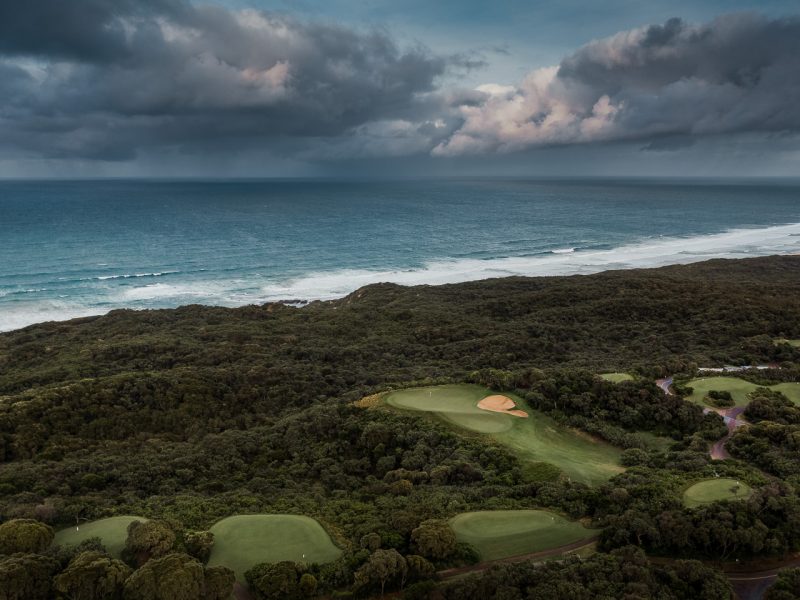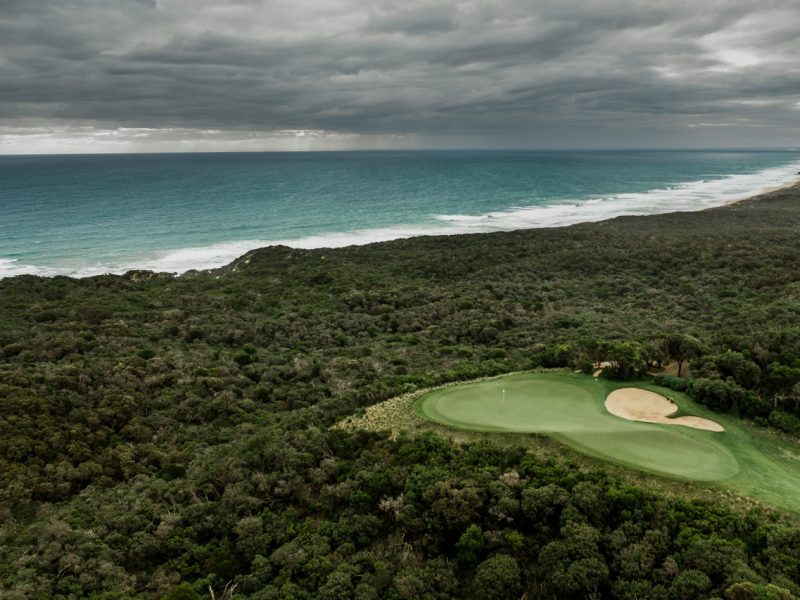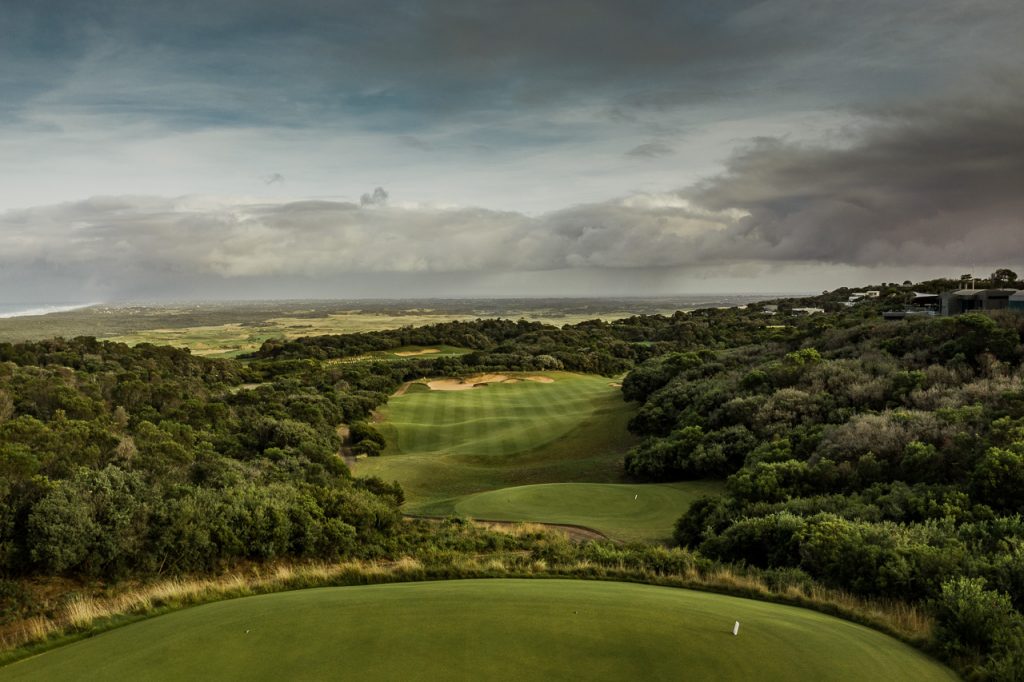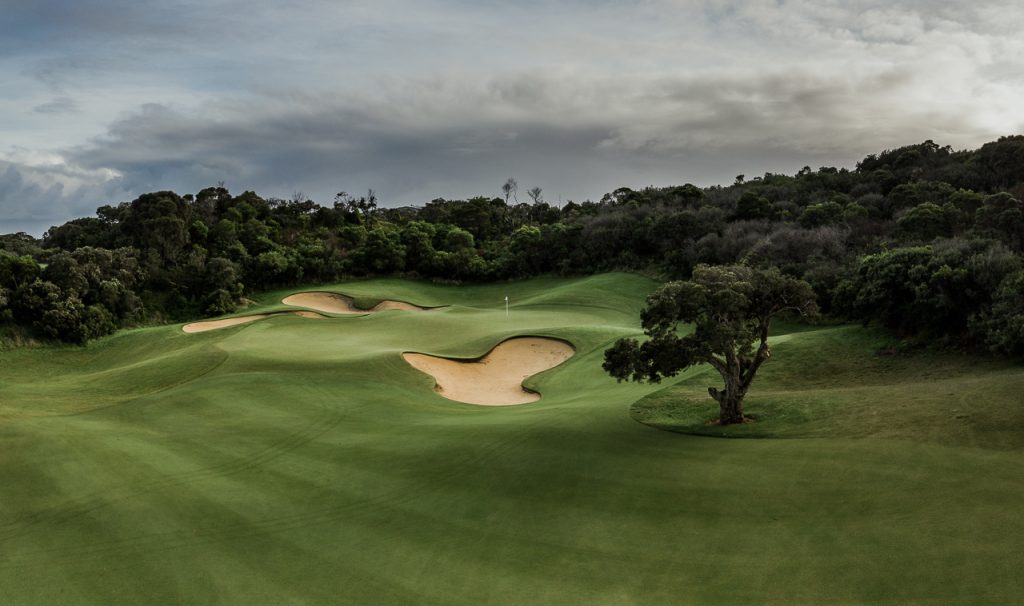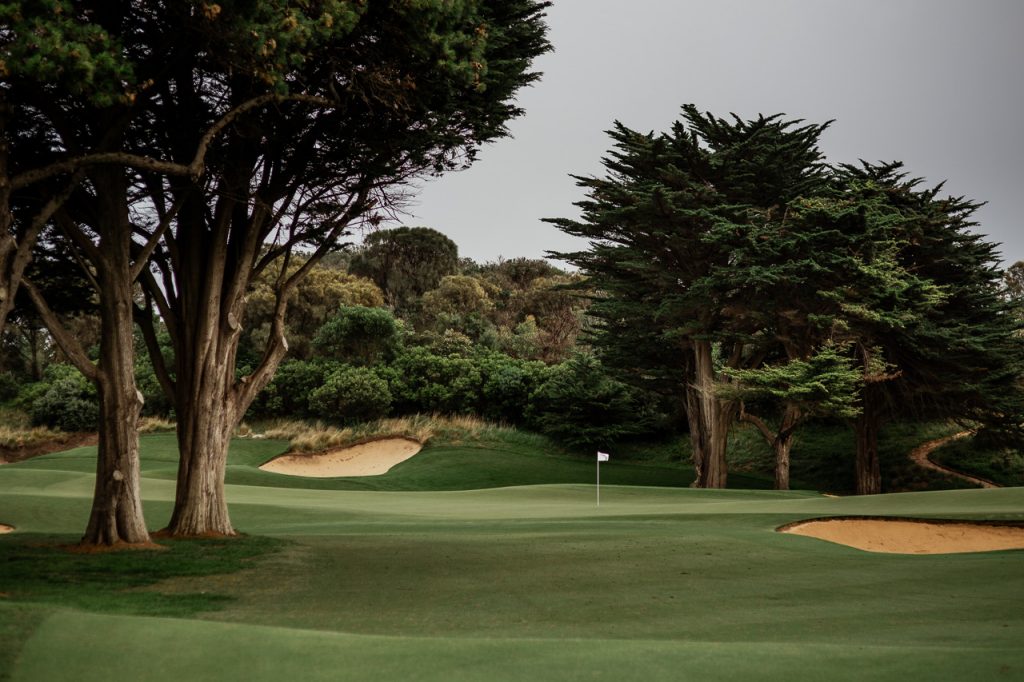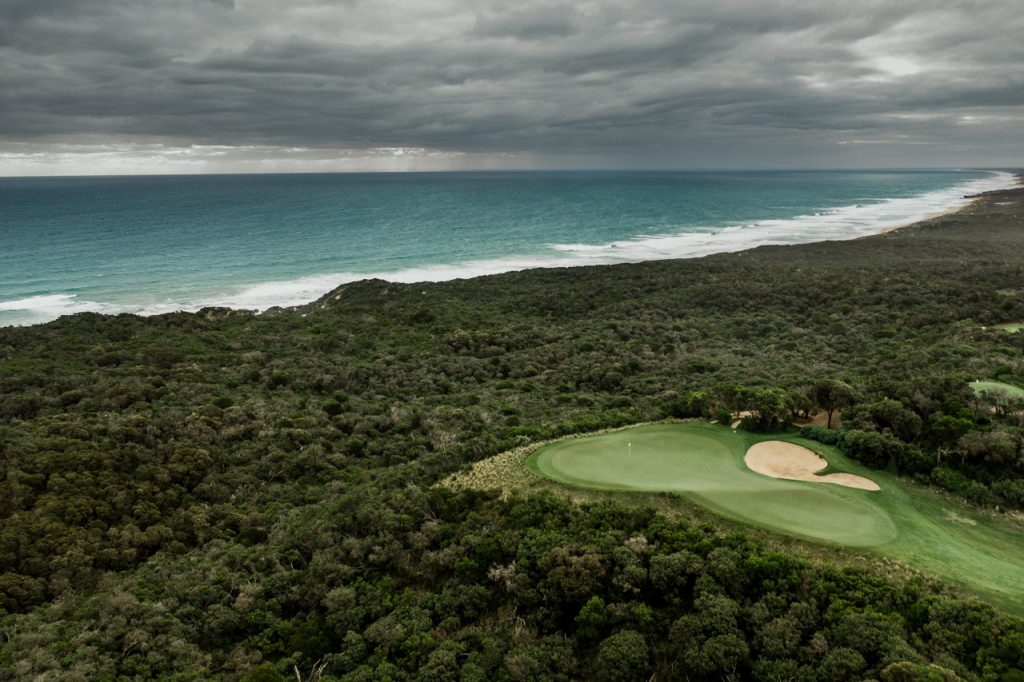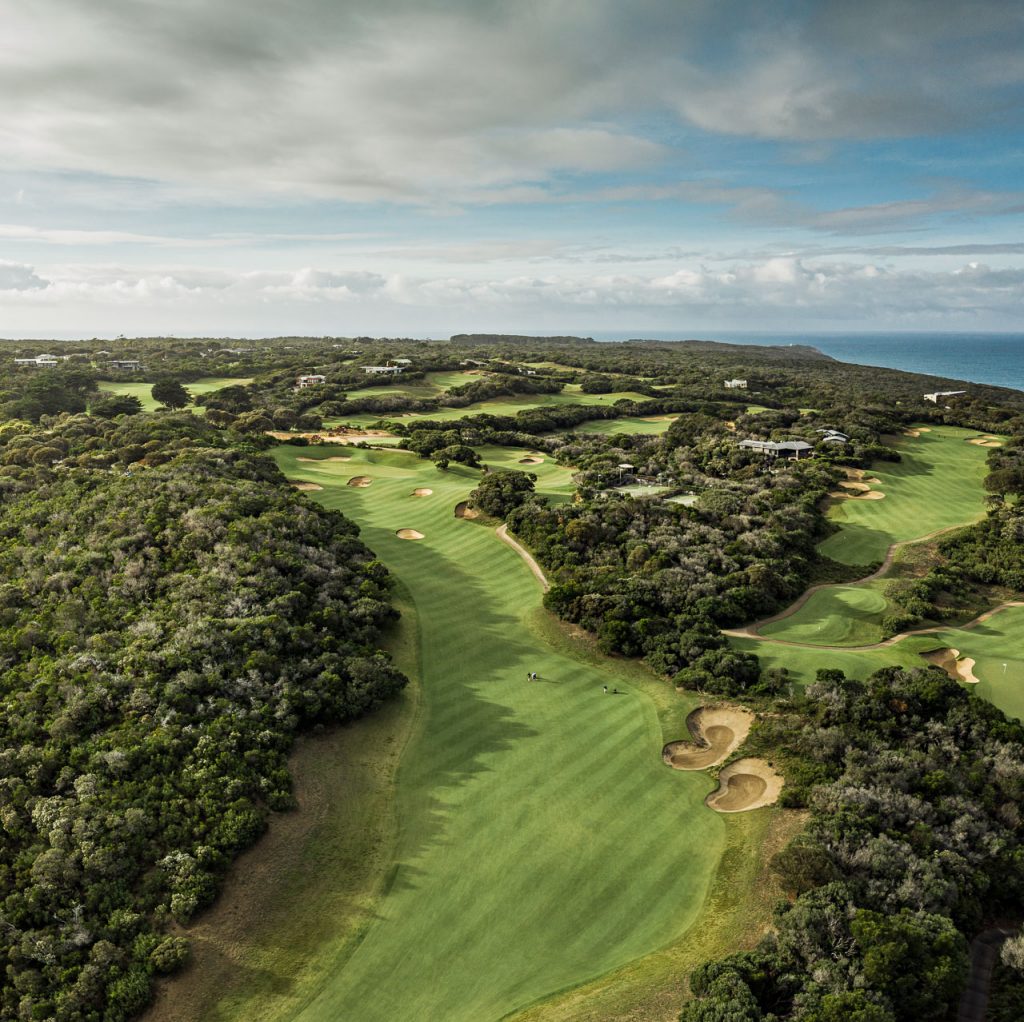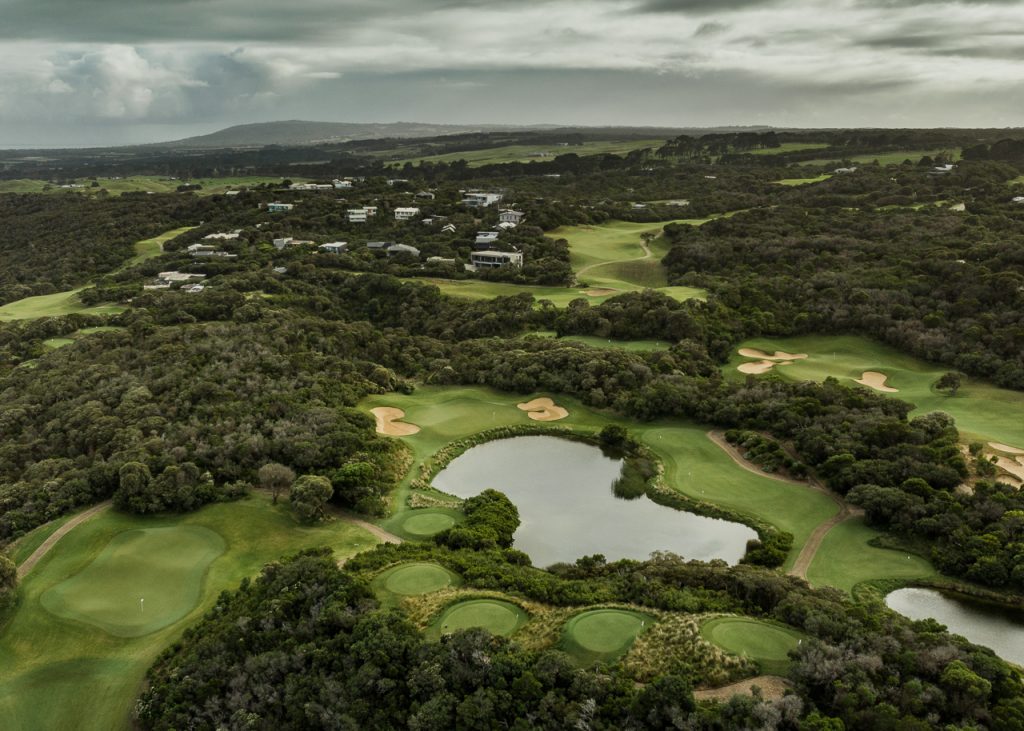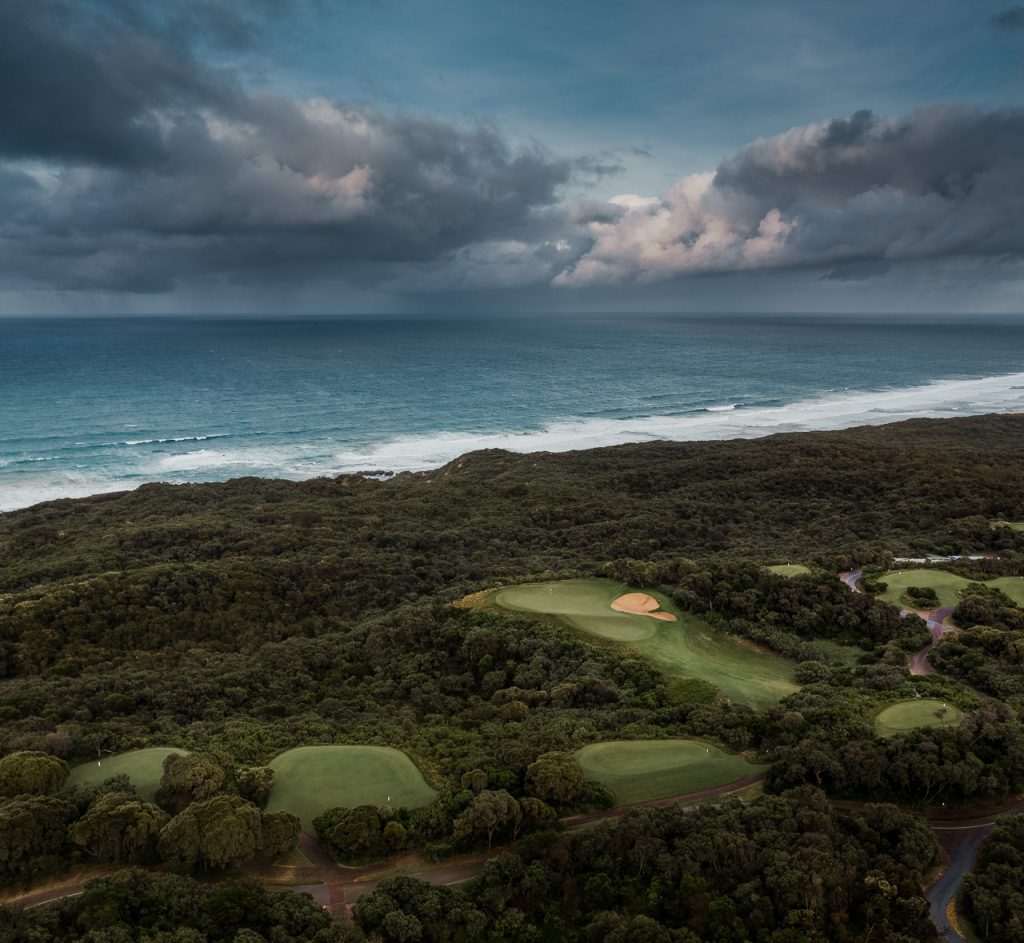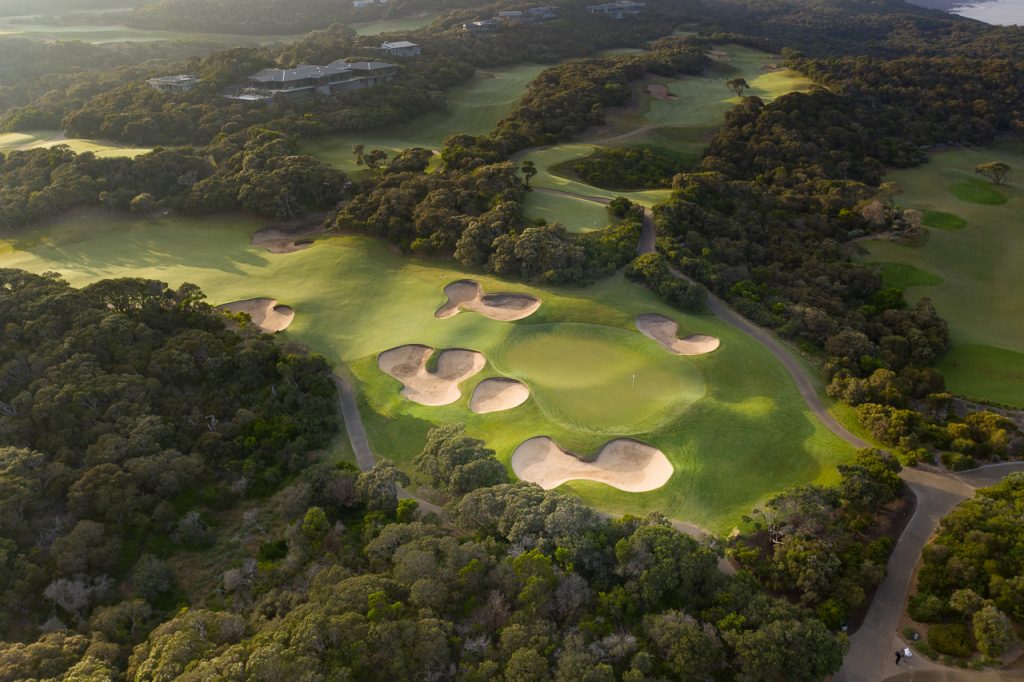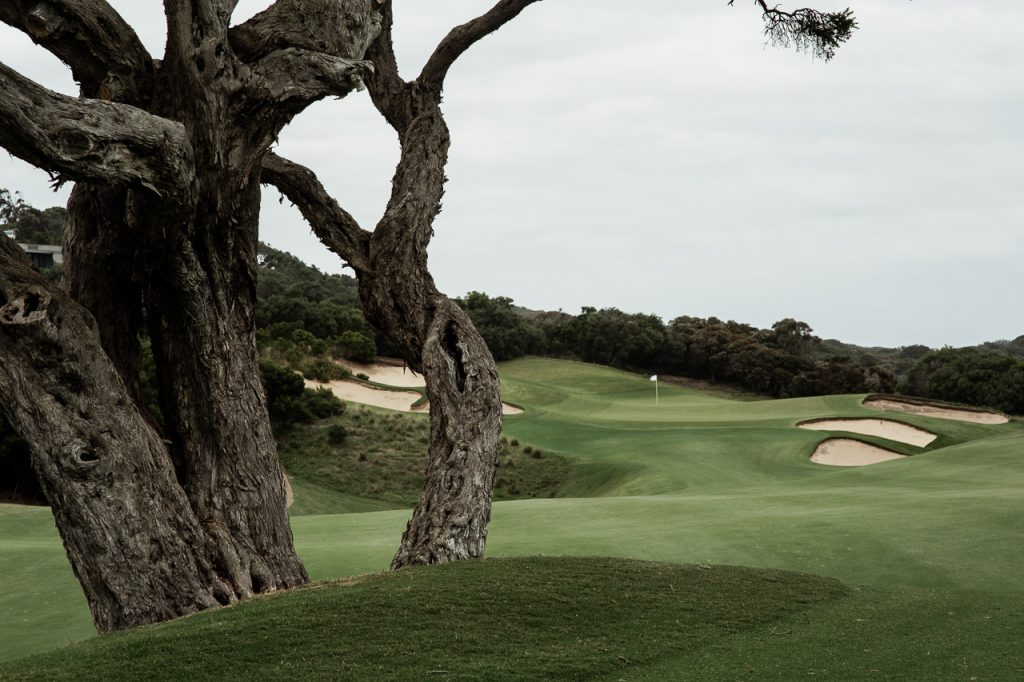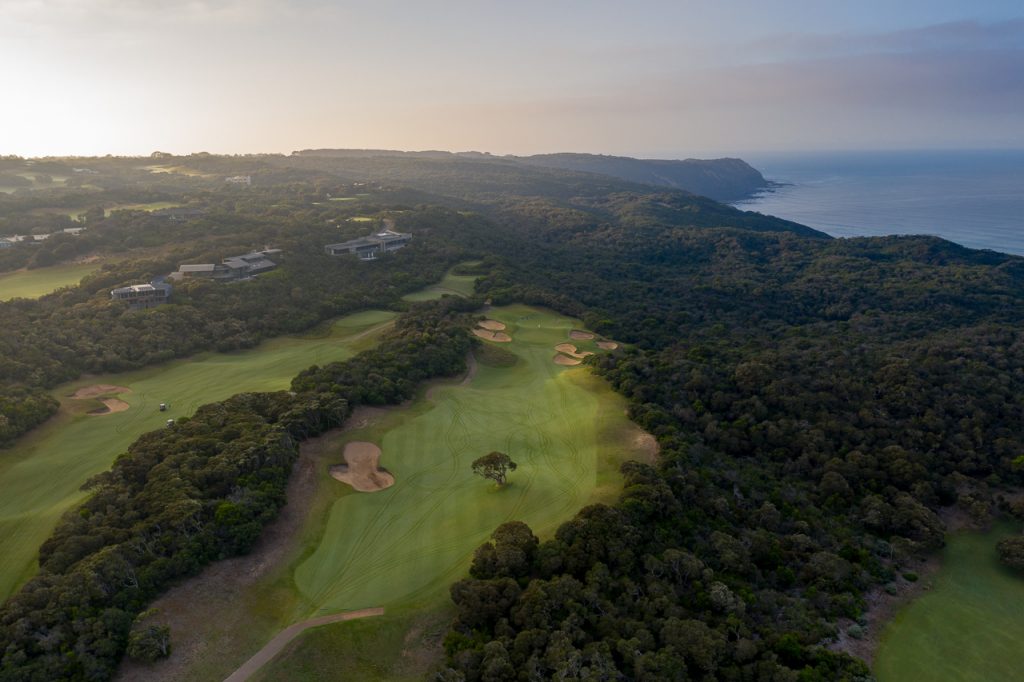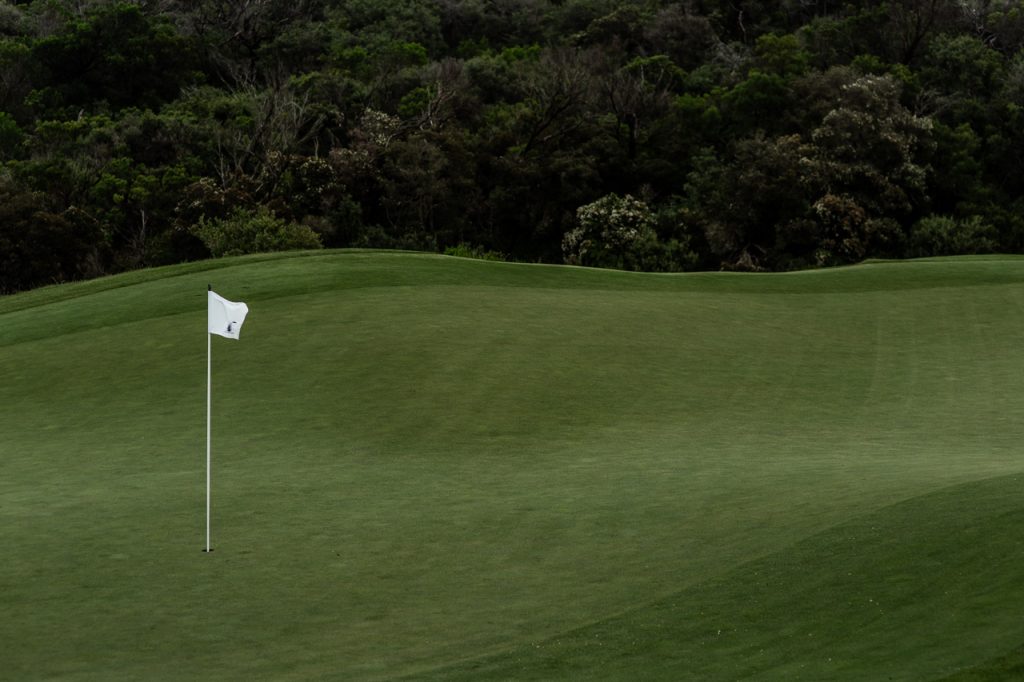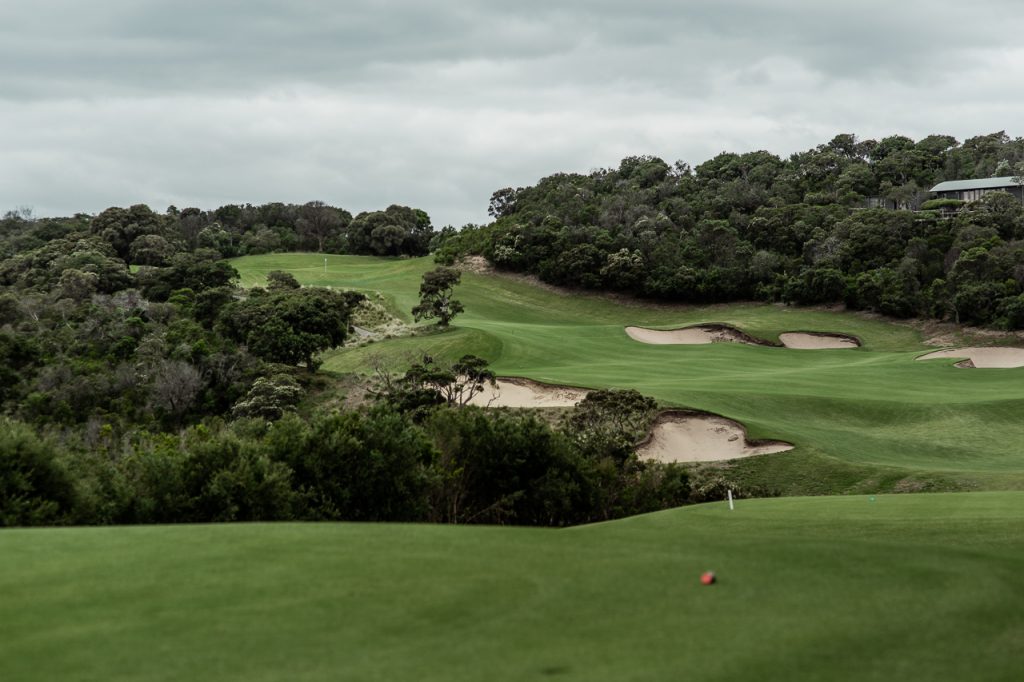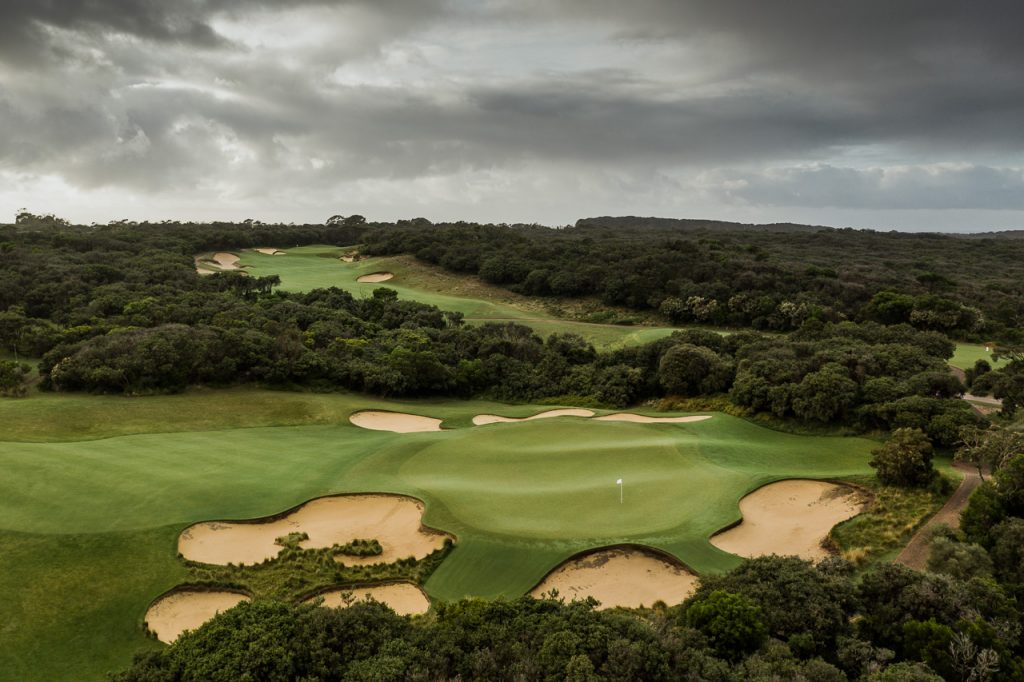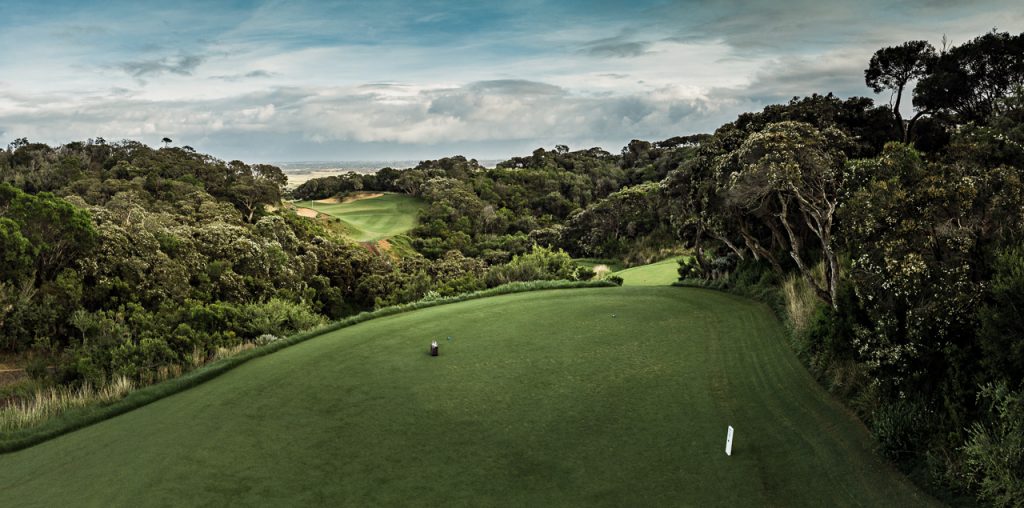The Old Course feature video
About the Course
Designed by Robert Trent Jones Jr, The Old Course is a dramatic layout constructed on heaving terrain, with fairways weaving between and over large sand dunes, bordered by tea tree and rich native coastal vegetation. With its deceptively wide fairways, undulating greens and dramatic views, The Old Course remains one of the premier layouts in the country, and amongst the more memorable anywhere in the world.
From the designer – Robert Trent Jones, Jr.
“The National Golf Club was a dream come true. Whenever a golf course architect is presented with sand to work, he knows he can cut it like a knife through butter, to shape the forms that are consistent with the links traditions of the game. In this case, the forms were already there with the high cathedral-like dunes similar to Royal Birkdale but even more dramatic. We walked through the bush and revealed the routing, then left it pretty much as we found it except some shaping of greens and carving in some bunkers.
“We think this is one of the true tests of golf and the game anywhere, especially when the wind is up, which is quite often. The golf course is a true test at the championship level for any player and as equipment gets better and better, it still withstands the young limberbacks lengthening attack. But on and around the greens, the old foxes, with their sure hands, will have a better opportunity to make pars and to keep the game interesting.
“If medal play is the test of golf, then match play is the test of character. This is a true match play course in its truest character and those who play The National Golf Club course and play their match will find it fascinating, with changing weather conditions, always different, always interesting and dramatically beautiful.”
The Old Course – The Breakdown
The Old Course – 1st Hole
Par-4
283m 300m 312m 342m
A simple tee shot to a wide fairway guarded by a bunker left, where the sole hidden problem is a hollow short left of the green reached only by long hitters. The prominent Moonah tree provides a good driving line since second shots from the right side of the fairway have a greater chance of settling on the green. The green, which is protected by deep bunkering, left and right, features three definite sections, the front half of which is at full green width and the left and right rear quarters.

The Old Course – 2nd Hole
Par-4
312m 358m 394m 420m
A challenging hole that bottlenecks at the ideal drive length where contouring causes balls to feed to the middle. Fairway bunkering right and a cavernous bunker at the front left of the green provide definition and should be avoided. Many conservative players elect to lay up short of this bunker with their second shot as it requires great accuracy to reach the front right entrance to the green Alternatively, the ball must be hit with enough elevation to hold the firm green.

The Old Course – 3rd Hole
Par-4
305m 313m 367m 390m
The drive over a deep valley is played to a fairway sloping upward to a semi-blind green. Strong players have a definite advantage here since they can reach a flatter section of the fairway, whilst weaker drives will tend to roll backwards. The second shot is played to a large, bunkerless green, where the surrounds at the right will see shots bounce toward the centre of the two-terraced green. Shots to the top terrace should be played with plenty of club as the dividing slope is severe.
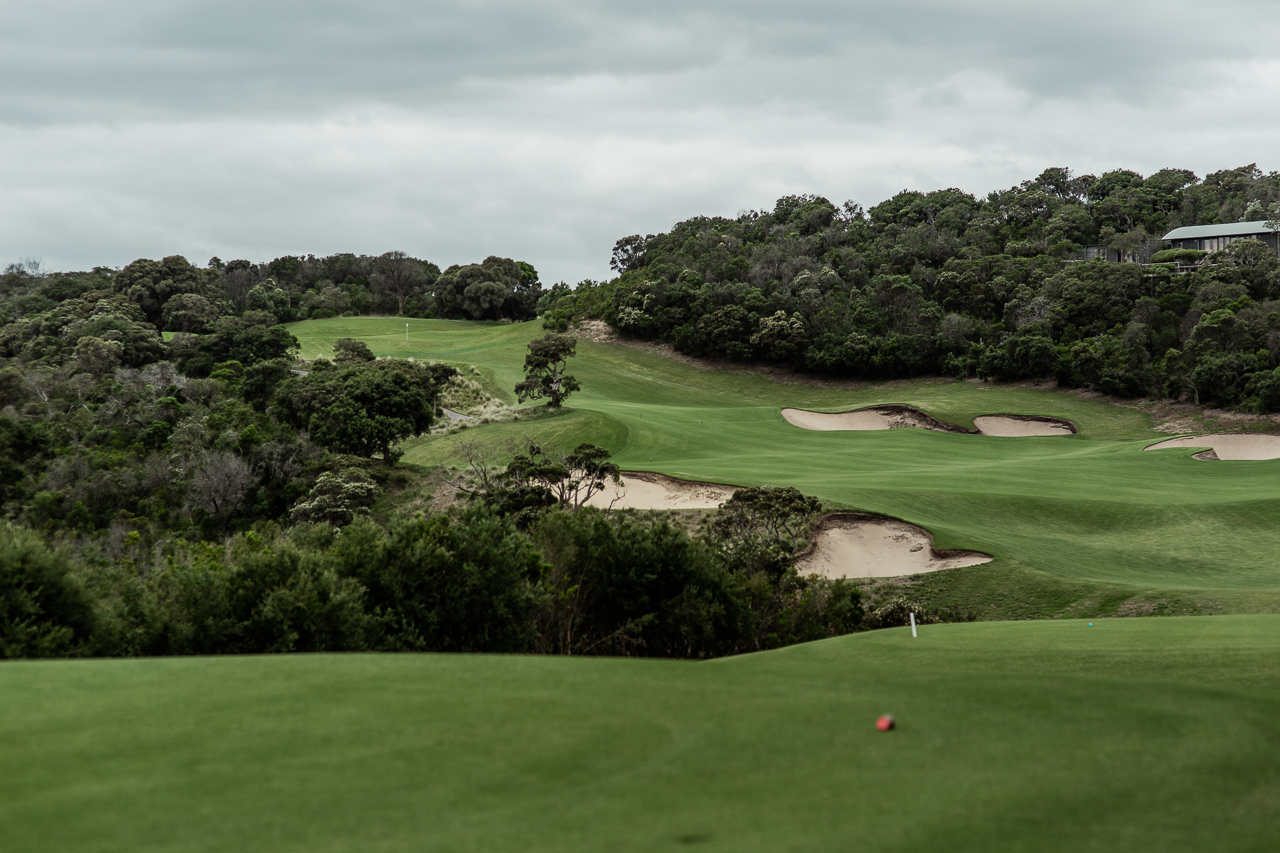
The Old Course – 4th Hole
Par-3
83m 120m 152m 165m
A visually exciting shot over a hazard from tees which, with one notable exception, are very elevated. Judgement of distance is the challenge, particularly on windy days. It is sound strategy to take an extra club and swing conservatively to enhance control by keeping the ball low. The large green has a spine, running from opposite the centre of the left bunker into the middle of the green, which influences most putts.

The Old Course – 5th Hole
Par-5
336m 393m 448m 475m
The drive on this dog leg left par 5 advantages the player who hits the ball right to left. Two bunkers at the end of the fairway through the dog leg are out of range for most. The second shot is played slightly uphill. The contours feed a lone but deep bunker in the centre of the fairway which must be avoided at all costs. Again, the green is divided by a spine with a sloping left section and a flatter right section. When playing approach shots to the left section, an ‘extra club’ is advised.
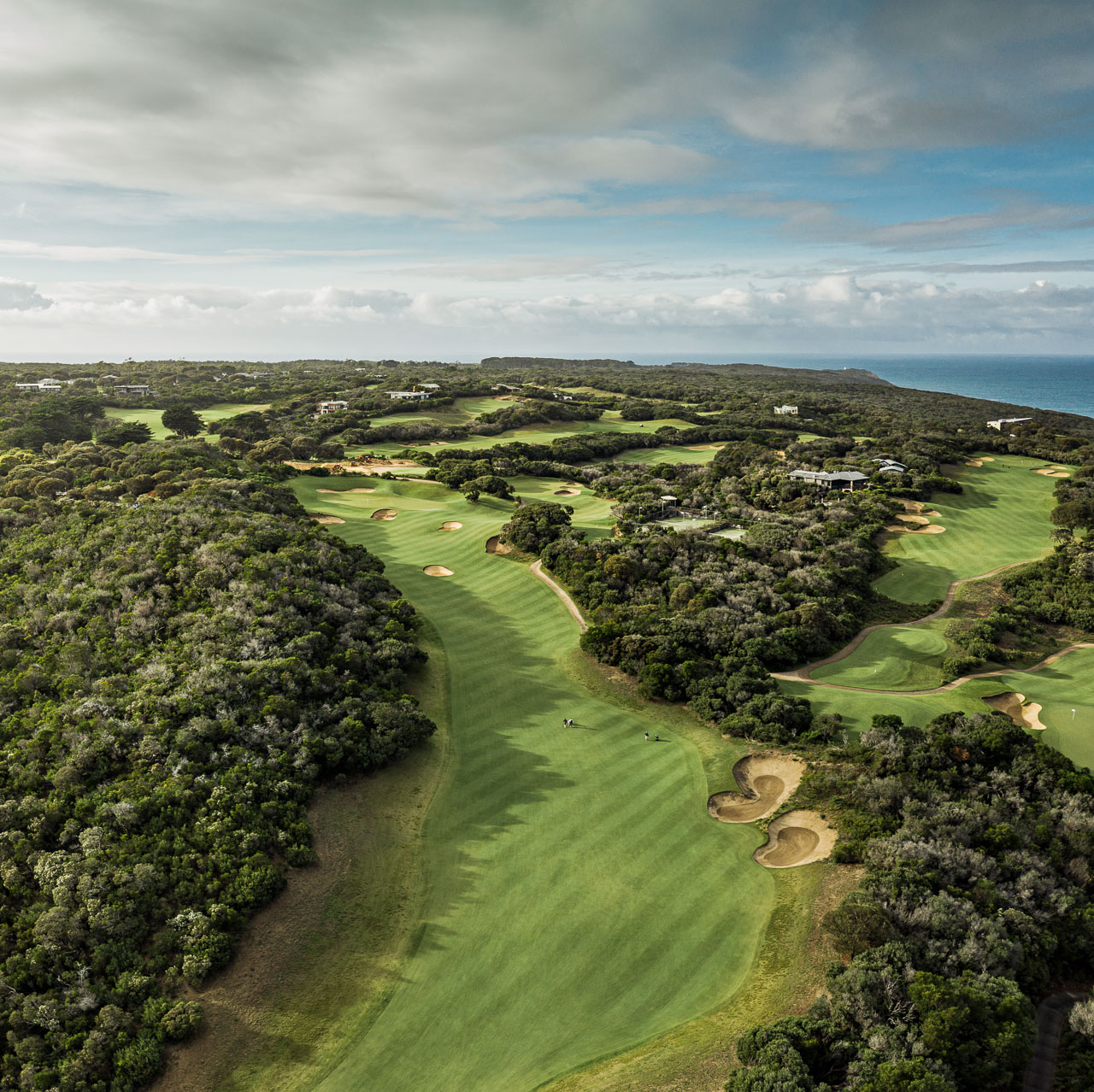
The Old Course – 6th Hole
Par-4
298m 316m 321m 344m
The fairway is generous in width until it bottlenecks beyond the corner of the dog leg, offering the choice of driving safely to the wider portion or trying to hit beyond the corner, where the camber can cause balls to gather in a deep hollow of rough to the right. Left and right greenside bunkers present great difficulty due to their depth. Shots to the front terrace of the green should be aimed well left. The steep bank behind the green can be used to good effect by allowing an approach to feed back down to the rear terrace.

The Old Course – 7th Hole
Par-3
101m 107m 121m 139m
The stunning topography enhanced by magnificent coastline views makes this The National’s signature hole. Club selection is critical. Whilst the green is particularly wide, anything hit short, long or left of the green is best forgotten. The deep bunker at the rear should be avoided and a shot to the wrong side of the spine dividing the green will more often than not produce a three putt. With the prevailing wind into the line of play, a quieter swing with an ‘extra club’ is recommended.
The Old Course – 8th Hole
Par-5
389m 400m 439m 473m
The fairway, which is obscured from the elevated tee, is of comfortable width with a helpful downslope. The wind direction will dictate the choice of club for those capable of driving the rough at the end of the first fairway section. The second shot is played to an elevated green which slopes from back to front. Downhill putts demand a delicate touch on the glassy surface. Conversely, uphill putts must be well struck.

The Old Course – 9th Hole
Par-4
277m 298m 367m 403m
Three deep fairway bunkers guard the left side with the fairway beyond cambered towards a grassy hollow on the right that is not visible from the tee. Tee shots directed centre left are therefore favoured. The choice of club for the second shot to a significantly contoured green will be influenced by prevailing wind conditions. When the hole is cut at the back left, an ‘extra club’ will be needed. Par can be saved from the right greenside bunkers but rarely from the two bunkers to the left.
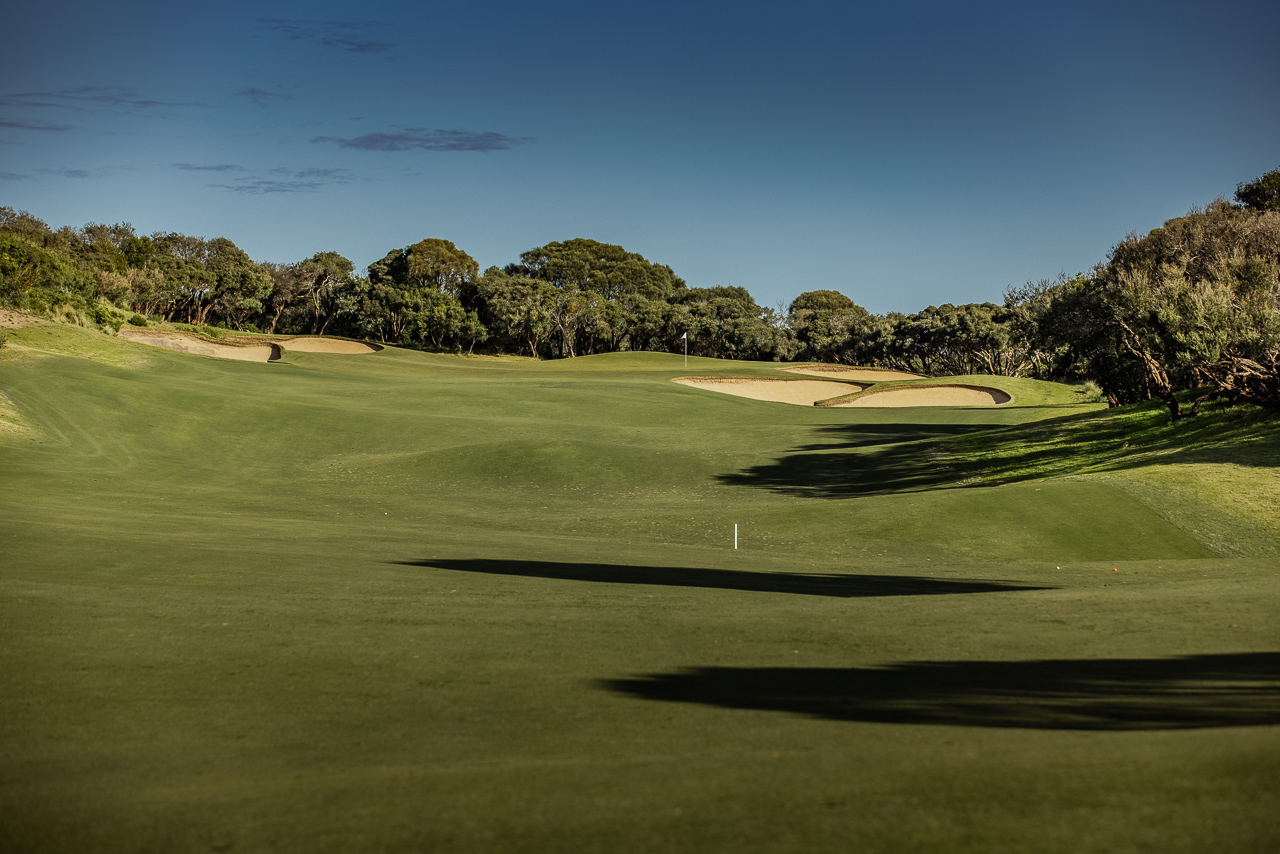
The Old Course – 10th Hole
Par-5
415m 452m 489m 521m
A dog leg left followed by a twist to the right. From the tee, the choice is offered to play safely to the right of two large fairway bunkers to a wide fairway, or to take on the bunkers and possibly bring the green into range for your next. Additinal fairway bunkers along the right will catch wayward second shots. Thick rough and deep bunkers left and back of the green are best avoided. The huge green is shared with the 14th. The hole lengthens considerably when the pin is located in the valley between.
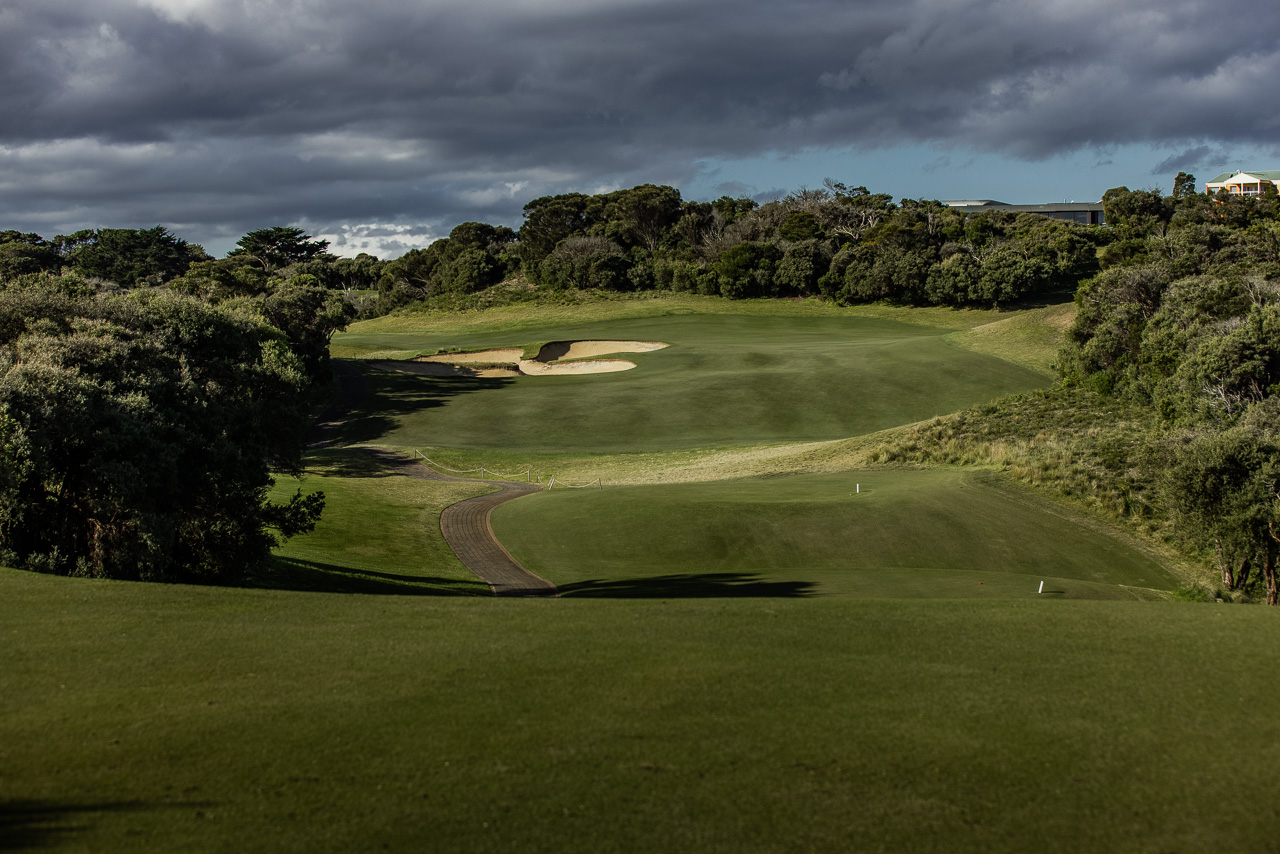
The Old Course – 11th Hole
Par-4
298m 322m 349m 371m
The blind tee shot is played over a rise to a wide fairway. Long drivers will take advantage of the downslope to set up a pitch to the green. Others will be left with a difficult second shot from a downhill lie. The green is divided into three sections by two severe spines. A shot to the middle section avoids the bunkers which attract short approach shots. If you find yourself in the wrong part of the green, a three putt beckons.
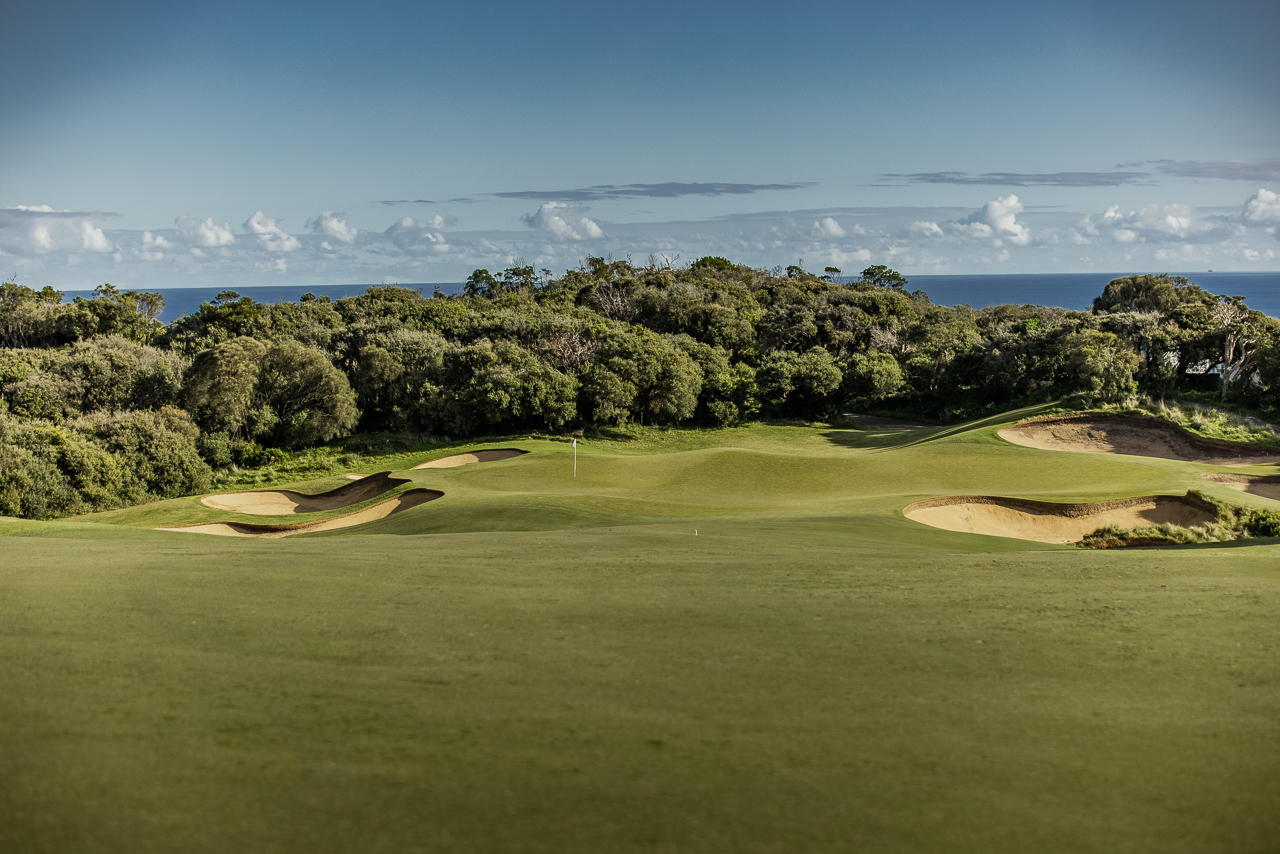
The Old Course – 12th Hole
Par-4
223m 236m 279m 308m
Big hitters may attempt to drive on or close to the green over the corner of a slight dog leg, whilst others may choose the safer option of an iron or 3 wood to the wider left side of the fairway. This hole presents a great birdie opportunity since it can be easily reached with a short iron second shot. A slightly obscured green guarded by a sandy wasteland to the right and a bunker left. Beware also of a severe fall-away to the rear.
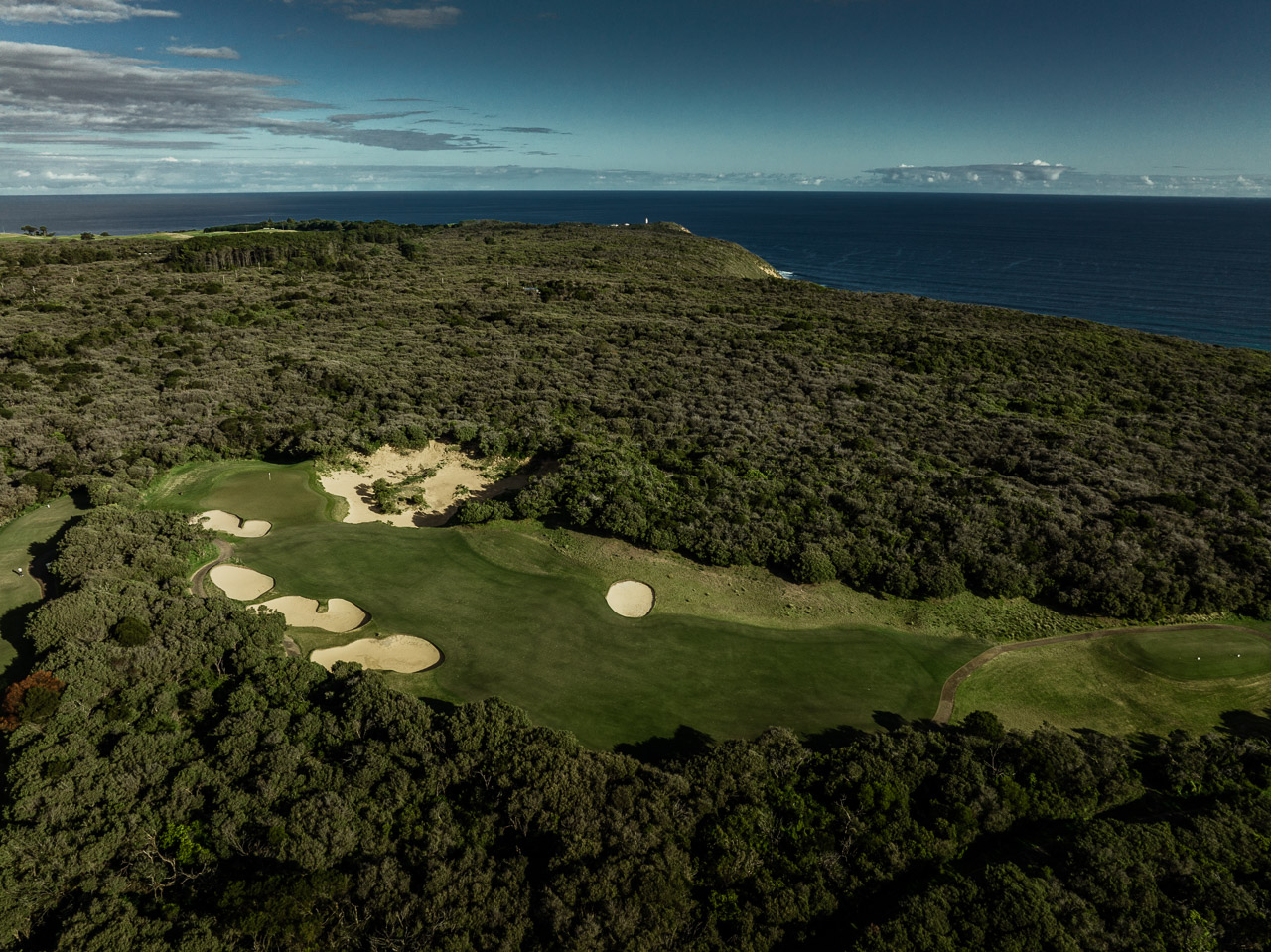
The Old Course – 13th Hole
Par-3
116m 135m 169m 198m
This long par 3 is normally played into the prevailing breeze. Tee shots with long irons and fairway woods tend to release forward on this firm, flat green. Par can often be saved from bunkers on both sides but the task is made more difficult when the pin is back. Putts from the front to back up over a deceptive rise need to be well struck whilst extreme care should be taken when putting from the rise when the hole is cut in the fast front portion of the green.
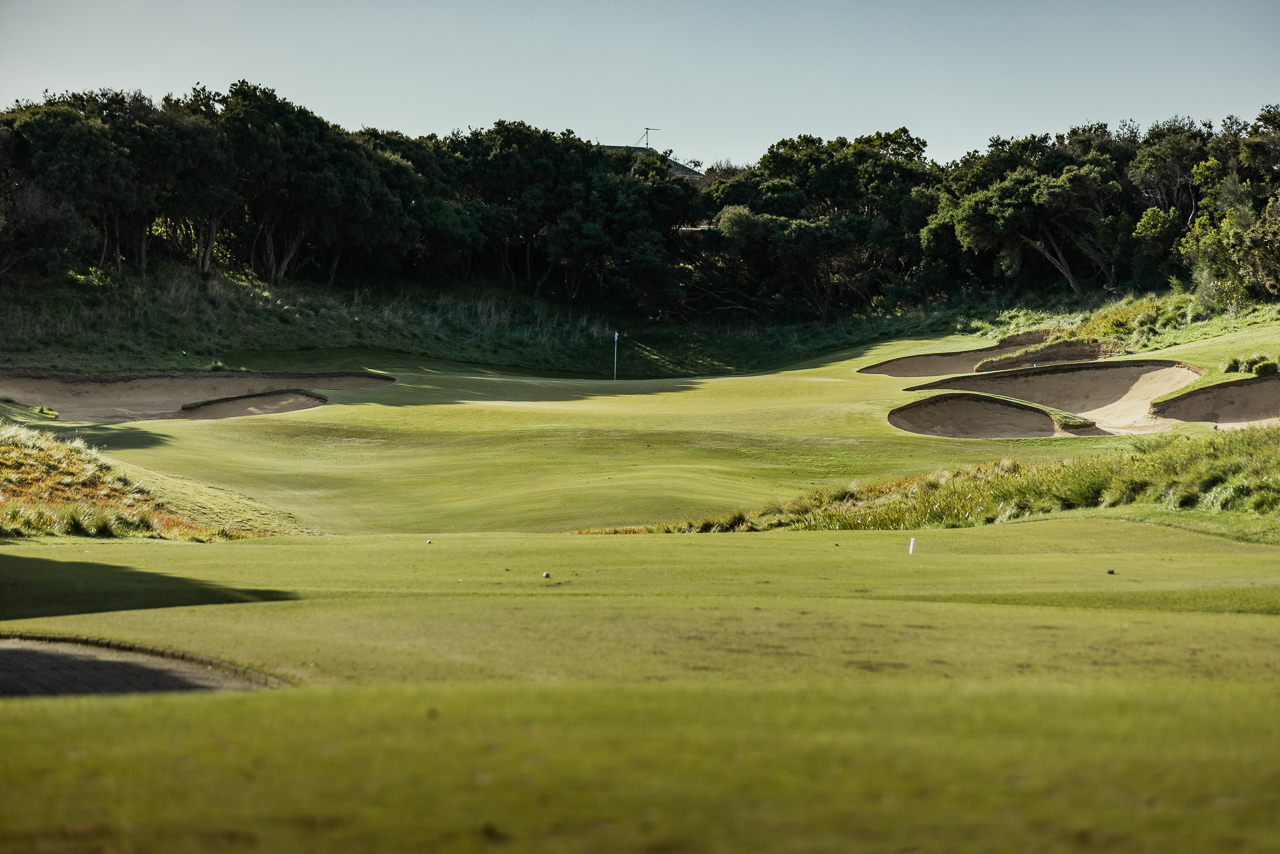
The Old Course – 14th Hole
Par-4
312m 343m 368m 390m
The powerful golfer has the option of driving the fairway bunkers and setting up an easy pitch to the green, but its a challenging carry. The safer play is to drive to a wide fairway to the right. In this instance, the second shot must be accurate to avoid not only the pine trees left and right of the green but also bunkers on the front left and on the back and front right. Over-clubbing often results in the ball finding the valley linking to the 10th green, making two putts a difficult task.
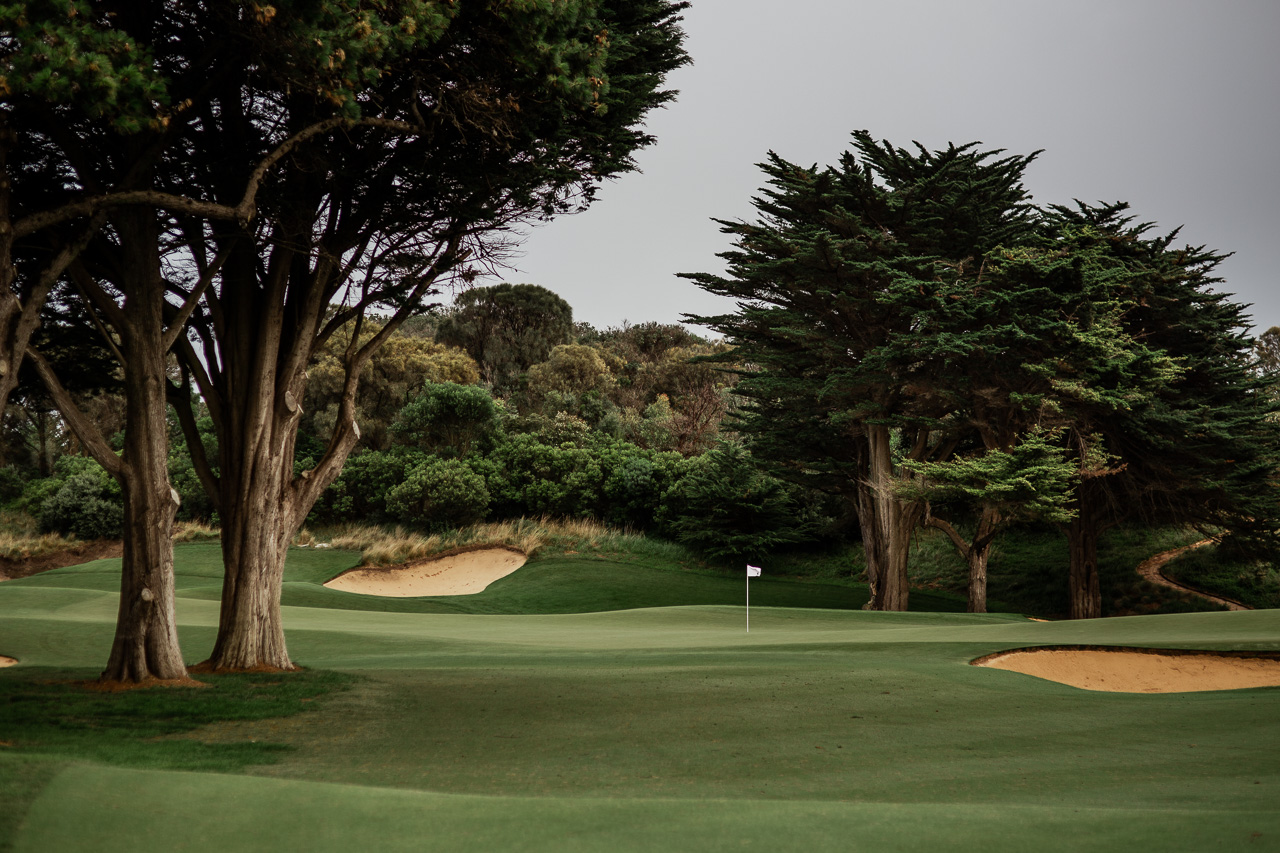
The Old Course – 15th Hole
Par-4
275m 325m 352m 358m
The ball must be struck solidly from the elevated tee as head winds often prevail. Drives short of the dog-leg corner leave blind second shots to a green with two distinct terraces. Bunkers at the end of the fairway and one past the tree-lined right side catch big hitters in favourable conditions. A moonah tree, dating to the last millennium, stands guard at the approach to the green. The task of club selection to find the correct terrace, is exacerbated by deep bunkers front and left rear.
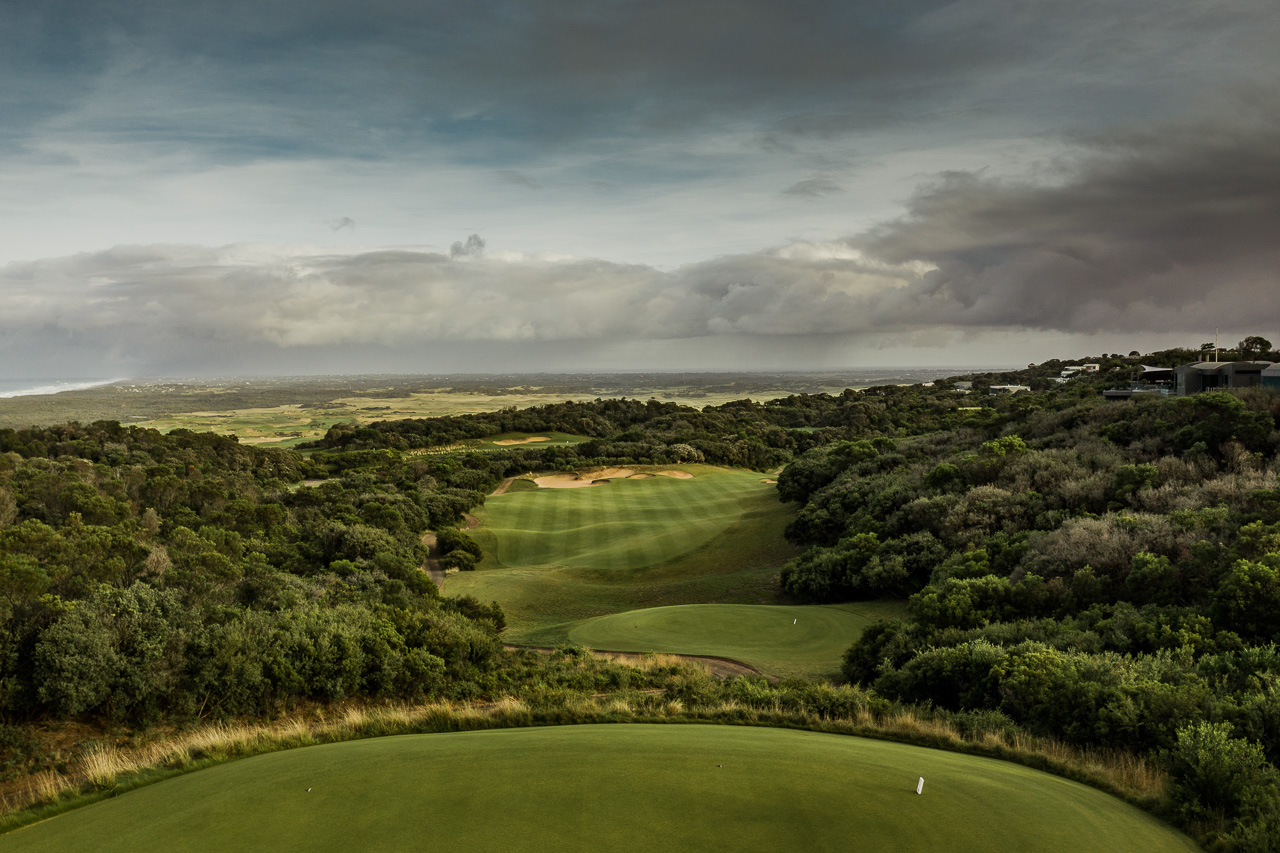
The Old Course – 16th Hole
Par-3
109m 124m 149m 168m
The tee shot is played through a deep valley to a relatively flat green against a backdrop of exquisite beauty. The funnel at the rear of the green often produces a contrary cross breeze which should be taken into account in club selection. For this reason the bunker at the back of the green is rarely troubled with many shots falling short into the valley at the front of the green. Shots hit back right, and those hit to the left side and which avoid the bunkers, usually find the green from contoured banks.

The Old Course – 17th Hole
Par-5
428m 466m 491m 511m
A rolling par 5 with spectacular ocean views, again with an option for big tee hitters to drive across the dog leg from the elevated tee (a carry of 250 metres from the back tee) setting up a possible second shot to the green. A more conventional approach avoids the left side fairway bunkers from the tee requiring the second shot to be played short of further fairway bunkers within pitching distance of the green. The green is split by a central spine and requires an accurate approach shot.
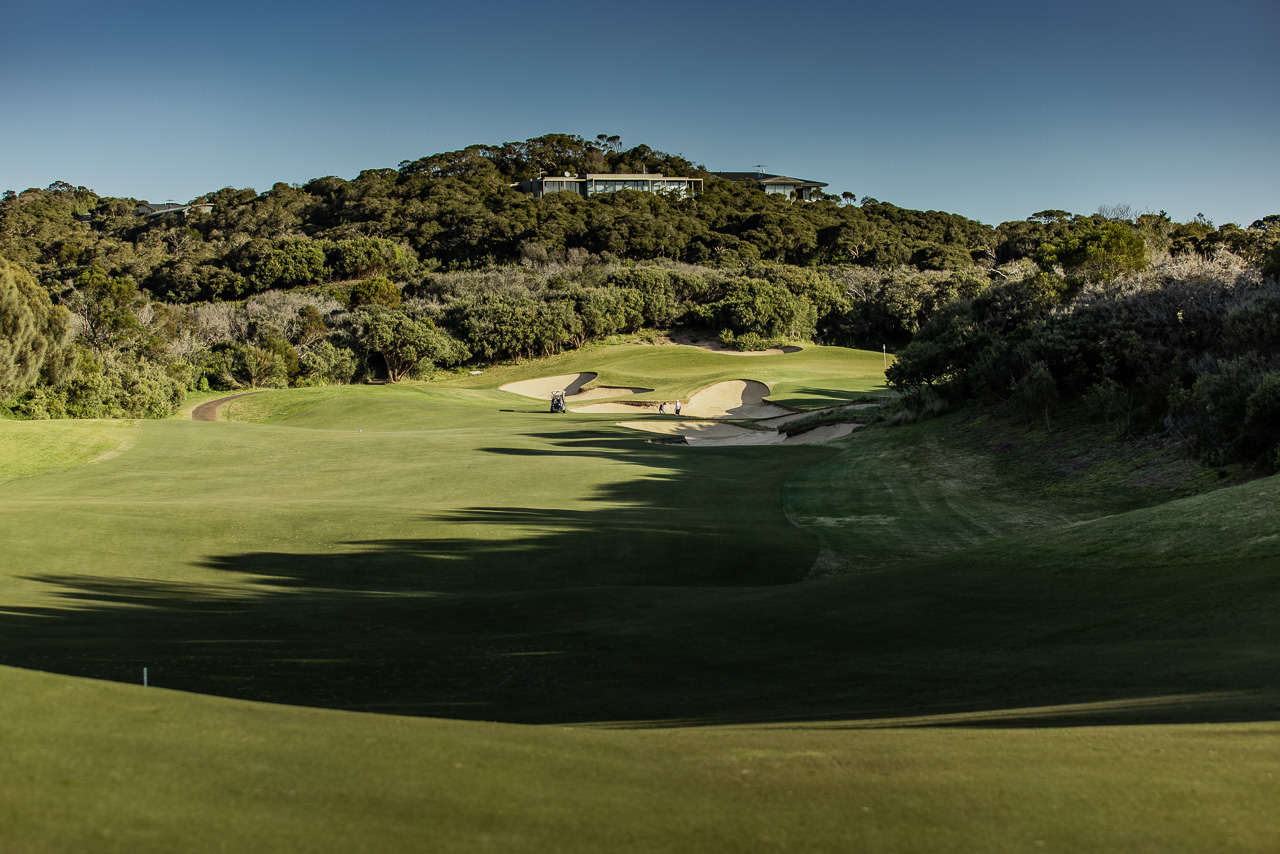
The Old Course – 18th Hole
Par-4
216m 277m 306m 337m
A true dog-leg with the tee and fairway protected by significant ridges on both sides. Right handers with a fade have the edge here. It is often sound strategy to play short of the visible fairway bunker, since reaching the green in two is rare from this hazard. Big hitters may aim right of the bunker to set up a pitch to the green which is surrounded by deep bunkering with a severe fall-away at the rear of the green. Finding the narrow back section of the green is difficult as it is invariably firm.
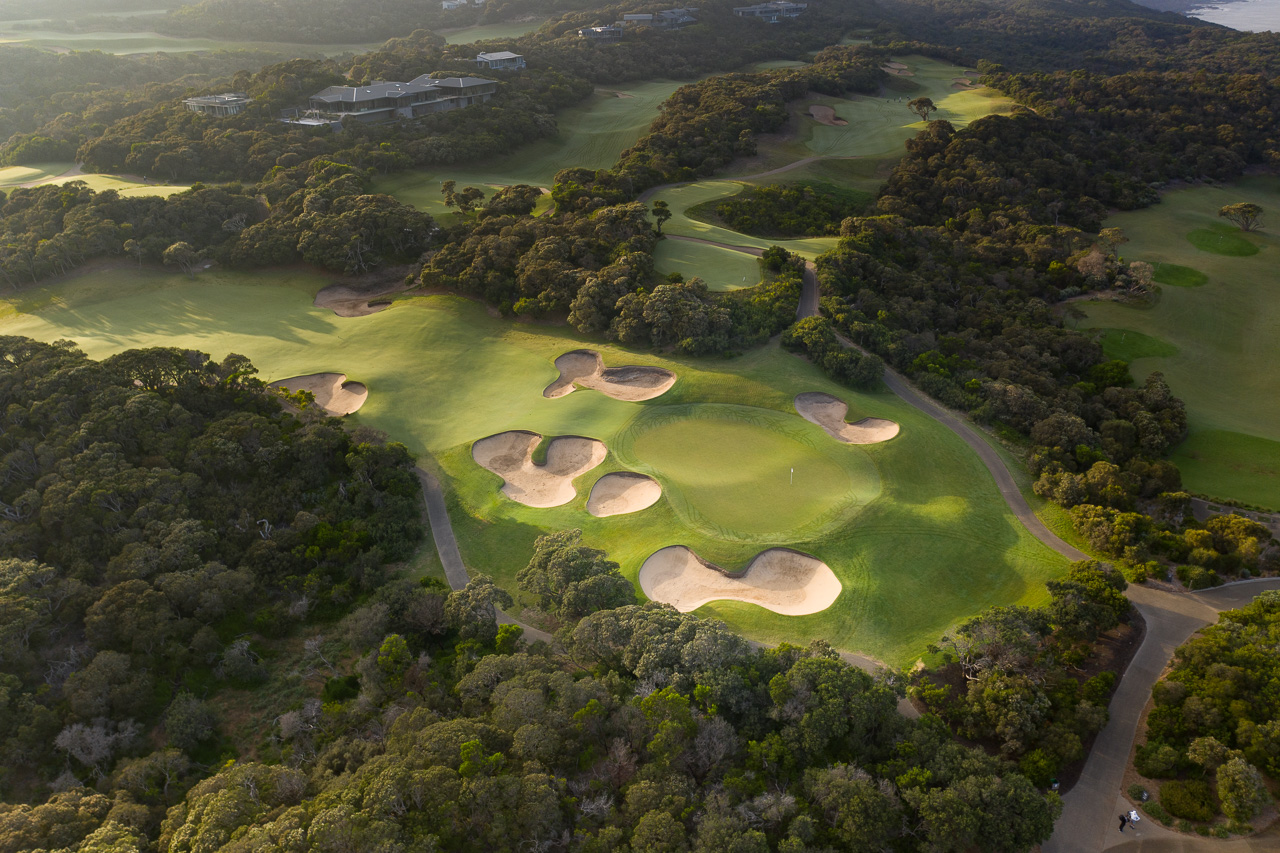
View Full Scorecard
Front Nine
| Hole | 1 | 2 | 3 | 4 | 5 | 6 | 7 | 8 | 9 | Out |
|---|---|---|---|---|---|---|---|---|---|---|
| Par | 4 | 4 | 4 | 3 | 5 | 4 | 3 | 5 | 4 | 36 |
| Burgundy Tees | 283 | 312 | 305 | 83 | 336 | 298 | 101 | 389 | 277 | 2384 |
| Silver Tees | 300 | 358 | 313 | 120 | 393 | 316 | 107 | 400 | 298 | 2605 |
| Blue Tees | 312 | 394 | 367 | 152 | 448 | 321 | 121 | 439 | 367 | 2921 |
| Black Tees | 342 | 420 | 390 | 165 | 475 | 344 | 139 | 473 | 403 | 3151 |
Back Nine
| Hole | 10 | 11 | 12 | 13 | 14 | 15 | 16 | 17 | 18 | In | Total |
|---|---|---|---|---|---|---|---|---|---|---|---|
| Par | 5 | 4 | 4 | 3 | 4 | 4 | 3 | 5 | 4 | 36 | 72 |
| Burgundy Tees | 415 | 298 | 223 | 116 | 312 | 275 | 109 | 428 | 216 | 2392 | 4776 |
| Silver Tees | 452 | 322 | 236 | 135 | 343 | 325 | 124 | 466 | 277 | 2680 | 5285 |
| Blue Tees | 489 | 349 | 279 | 169 | 368 | 352 | 149 | 491 | 306 | 2952 | 5873 |
| Black Tees | 521 | 371 | 308 | 198 | 390 | 358 | 168 | 511 | 337 | 3162 | 6313 |
The Old Course – The Breakdown
The Old Course – 1st Hole
Par-4 7 18
304m 304m 312m 342m
A simple tee shot to a wide fairway guarded by a bunker left, where the sole hidden problem is a hollow short left of the green reached only by long hitters. The prominent Moonah tree provides a good driving line since second shots from the right side of the fairway have a greater chance of settling on the green. The green, which is protected by deep bunkering, left and right, features three definite sections, the front half of which is at full green width and the left and right rear quarters.
The Old Course – 2nd Hole
Par-4 2 8
312m 358m 394m 420m
A challenging hole that bottlenecks at the ideal drive length where contouring causes balls to feed to the middle. Fairway bunkering right and a cavernous bunker at the front left of the green provide definition and should be avoided. Many conservative players elect to lay up short of this bunker with their second shot as it requires great accuracy to reach the front right entrance to the green Alternatively, the ball must be hit with enough elevation to hold the firm green.
The Old Course – 3rd Hole
Par-4 1 12
313m 348m 367m 390m
The drive over a deep valley is played to a fairway sloping upward to a semi-blind green. Strong players have a definite advantage here since they can reach a flatter section of the fairway, whilst weaker drives will tend to roll backwards. The second shot is played to a large, bunkerless green, where the surrounds at the right will see shots bounce toward the centre of the two-terraced green. Shots to the top terrace should be played with plenty of club as the dividing slope is severe.
The Old Course – 4th Hole
Par-3 9 3
83m 120m 152m 165m
A visually exciting shot over a hazard from tees which, with one notable exception, are very elevated. Judgement of distance is the challenge, particularly on windy days. It is sound strategy to take an extra club and swing conservatively to enhance control by keeping the ball low. The large green has a spine, running from opposite the centre of the left bunker into the middle of the green, which influences most putts.
The Old Course – 5th Hole
Par-5 13 14
393m 434m 448m 475m
The drive on this dog leg left par 5 advantages the player who hits the ball right to left. Two bunkers at the end of the fairway through the dog leg are out of range for most. The second shot is played slightly uphill. The contours feed a lone but deep bunker in the centre of the fairway which must be avoided at all costs. Again, the green is divided by a spine with a sloping left section and a flatter right section. When playing approach shots to the left section, an ‘extra club’ is advised.
The Old Course – 6th Hole
Par-4 11 6
298m 298m 321m 344m
The fairway is generous in width until it bottlenecks beyond the corner of the dog leg, offering the choice of driving safely to the wider portion or trying to hit beyond the corner, where the camber can cause balls to gather in a deep hollow of rough to the right. Left and right greenside bunkers present great difficulty due to their depth. Shots to the front terrace of the green should be aimed well left. The steep bank behind the green can be used to good effect by allowing an approach to feed back down to the rear terrace.
The Old Course – 7th Hole
Par-3 17 10
101m 107m 121m 139m
The stunning topography enhanced by magnificent coastline views makes this The National’s signature hole. Club selection is critical. Whilst the green is particularly wide, anything hit short, long or left of the green is best forgotten. The deep bunker at the rear should be avoided and a shot to the wrong side of the spine dividing the green will more often than not produce a three putt. With the prevailing wind into the line of play, a quieter swing with an ‘extra club’ is recommended.
The Old Course – 8th Hole
Par-5 15 1
400m 400m 439m 473m
The fairway, which is obscured from the elevated tee, is of comfortable width with a helpful downslope. The wind direction will dictate the choice of club for those capable of driving the rough at the end of the first fairway section. The second shot is played to an elevated green which slopes from back to front. Downhill putts demand a delicate touch on the glassy surface. Conversely, uphill putts must be well struck.
The Old Course – 9th Hole
Par-4 4 16
298m 298m 367m 403m
Three deep fairway bunkers guard the left side with the fairway beyond cambered towards a grassy hollow on the right that is not visible from the tee. Tee shots directed centre left are therefore favoured. The choice of club for the second shot to a significantly contoured green will be influenced by prevailing wind conditions. When the hole is cut at the back left, an ‘extra club’ will be needed. Par can be saved from the right greenside bunkers but rarely from the two bunkers to the left.
The Old Course – 10th Hole
Par-5 12 5
415m 452m 489m 521m
A dog leg left followed by a twist to the right. From the tee, the choice is offered to play safely to the right of two large fairway bunkers to a wide fairway, or to take on the bunkers and possibly bring the green into range for your next. Additinal fairway bunkers along the right will catch wayward second shots. Thick rough and deep bunkers left and back of the green are best avoided. The huge green is shared with the 14th. The hole lengthens considerably when the pin is located in the valley between.
The Old Course – 11th Hole
Par-4 10 11
318m 318m 349m 371m
The blind tee shot is played over a rise to a wide fairway. Long drivers will take advantage of the downslope to set up a pitch to the green. Others will be left with a difficult second shot from a downhill lie. The green is divided into three sections by two severe spines. A shot to the middle section avoids the bunkers which attract short approach shots. If you find yourself in the wrong part of the green, a three putt beckons.
The Old Course – 12th Hole
Par-4 18 2
232m 232m 279m 308m
Big hitters may attempt to drive on or close to the green over the corner of a slight dog leg, whilst others may choose the safer option of an iron or 3 wood to the wider left side of the fairway. This hole presents a great birdie opportunity since it can be easily reached with a short iron second shot. A slightly obscured green guarded by a sandy wasteland to the right and a bunker left. Beware also of a severe fall-away to the rear.
The Old Course – 13th Hole
Par-3 6 15
135m 135m 169m 198m
This long par 3 is normally played into the prevailing breeze. Tee shots with long irons and fairway woods tend to release forward on this firm, flat green. Par can often be saved from bunkers on both sides but the task is made more difficult when the pin is back. Putts from the front to back up over a deceptive rise need to be well struck whilst extreme care should be taken when putting from the rise when the hole is cut in the fast front portion of the green.
The Old Course – 14th Hole
Par-4 3 7
336m 336m 368m 390m
The powerful golfer has the option of driving the fairway bunkers and setting up an easy pitch to the green, but its a challenging carry. The safer play is to drive to a wide fairway to the right. In this instance, the second shot must be accurate to avoid not only the pine trees left and right of the green but also bunkers on the front left and on the back and front right. Over-clubbing often results in the ball finding the valley linking to the 10th green, making two putts a difficult task.
The Old Course – 15th Hole
Par-4 5 13
325m 325m 352m 358m
The ball must be struck solidly from the elevated tee as head winds often prevail. Drives short of the dog-leg corner leave blind second shots to a green with two distinct terraces. Bunkers at the end of the fairway and one past the tree-lined right side catch big hitters in favourable conditions. A moonah tree, dating to the last millennium, stands guard at the approach to the green. The task of club selection to find the correct terrace, is exacerbated by deep bunkers front and left rear.
The Old Course – 16th Hole
Par-3 14 4
109m 124m 149m 168m
The tee shot is played through a deep valley to a relatively flat green against a backdrop of exquisite beauty. The funnel at the rear of the green often produces a contrary cross breeze which should be taken into account in club selection. For this reason the bunker at the back of the green is rarely troubled with many shots falling short into the valley at the front of the green. Shots hit back right, and those hit to the left side and which avoid the bunkers, usually find the green from contoured banks.
The Old Course – 17th Hole
Par-5 16 17
428m 466m 491m 511m
A rolling par 5 with spectacular ocean views, again with an option for big tee hitters to drive across the dog leg from the elevated tee (a carry of 250 metres from the back tee) setting up a possible second shot to the green. A more conventional approach avoids the left side fairway bunkers from the tee requiring the second shot to be played short of further fairway bunkers within pitching distance of the green. The green is split by a central spine and requires an accurate approach shot.
The Old Course – 18th Hole
Par-4 8 9
272m 277m 306m 337m
A true dog-leg with the tee and fairway protected by significant ridges on both sides. Right handers with a fade have the edge here. It is often sound strategy to play short of the visible fairway bunker, since reaching the green in two is rare from this hazard. Big hitters may aim right of the bunker to set up a pitch to the green which is surrounded by deep bunkering with a severe fall-away at the rear of the green. Finding the narrow back section of the green is difficult as it is invariably firm.



